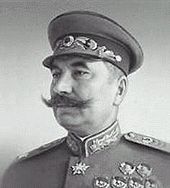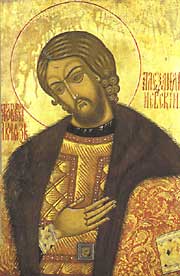Semyon Budyonny
| Semyon Mikhailovich Budyonny | |
|---|---|
| April 24, 1883 – February 10, 1973 (aged 90) | |
 Marshal of the Soviet Union Semyon Mikhailovich Budyonny. |
|
| Place of birth | Rostov Oblast, Russian Empire |
| Place of death | Moscow |
| Allegiance | |
| Service/branch | Imperial Russian Army |
| Years of service | 1917 — 1970 |
| Rank | Marshal of the Soviet Union |
| Commands held | 1st Red Army Cavalry Corps, 1st Red Cavalry Army |
| Battles/wars | Russo-Japanese War World War I Russian Civil War Polish-Soviet War World War II |
| Awards | Order of Lenin Order of the Red Banner Hero of the Soviet Union Order of Lenin Order of the October Revolution Order of Suvorov, 1st Class Order of Victory Cross of St. George |
Semyon Mikhailovich Budyonny (also spelled Budennii, Budenny, Budyoni, Budyenny, etc, Russian: Семён Миха́йлович Будённый) (April 25 [O.S. April 13] 1883 – October 26, 1973) was a Soviet military commander and an ally of Soviet leader Joseph Stalin.
Contents |
Early life
Budyonny was born into a poor peasant family in the Don Cossack region of southern Russia (now Rostov Oblast). Contrary to what many believe, although he grew up in a Cossack region, Budyonny was not a Cossack—his family actually came from Voronezh province. He worked as a farm laborer until 1903, when he was drafted into the army of the Russian Empire, becoming a cavalryman and serving in the Russo-Japanese War of 1905. During World War I he was a non-commissioned officer on the western front until 1916, when he was transferred to the Caucasus front. He became famous for his military courage and was four times awarded the St. George Cross. When the Russian Revolution overthrew the Tsarist regime in 1917, he was radicalized like many soldiers and became a leading member of the soldiers' councils (Soviets) in the Caucasus area.
During the Russian Civil War
The Civil War broke out in 1918, and Budyonny organised a Red Cavalry force in the Don region, which eventually became the 1st Cavalry Army. This Army played an important role in winning the Civil War for the Bolsheviks, driving the White General Anton Denikin back from Moscow. Budyonny joined the Bolshevik party in 1919, and formed close relationships with Joseph Stalin and Kliment Voroshilov.
In 1920 Budyonny's Cavalry Army took part in the invasion of Poland in the Polish-Soviet War, in which it was quite successful at first, pushing Polish forces out of Ukraine and later breaking through Polish southern frontlines. However later the Bolsheviks forces sustained a heavy defeat in the Battle of Warsaw, mainly because Budyonny's Army was bogged down at Lwów. After his army was defeated in the Battle of Komarów (one of the biggest cavalry battles in history), Budyonny was then sent south to fight the Whites in Ukraine and the Crimea. Despite the defeat in Poland, he was one of Soviet Russia's military heroes by the end of the Civil War.
Budyonny was considered a courageous and colorful cavalry officer, but knew little about modern warfare, particularly the impact of tanks. It is a measure of his military expertise that during Tukhachevsky's purge trial, he screamed that Tukhachevsky's effort to create armoured formations amounted to "wrecking", to which the doomed Tukhachevsky replied "I feel I'm dreaming". He was appointed to the position of Cavalry Inspector of the Red Army and similar honorific posts.
Later military career

In 1935 Budyonny was made one of the first five Marshals of the Soviet Union. Three of these five were executed in the Great Purge of the late 1930s, leaving only Budyonny and Voroshilov. In 1937 Budyonny commanded the Moscow Military District.
In July-September 1941, Budyonny was Commander-in-Chief (главком, glavkom) of the Soviet armed forces of the Southwestern Direction (Southwestern and Southern Fronts) facing the German invasion of Ukraine. This invasion began as part of Germany's Operation Barbarossa which was launched on June 22. Budyonny's forces were eventually surrounded during the Battle of Uman and the Battle of Kiev. The disasters which followed encirclement cost the Soviet Union 1.5 million men killed or taken prisoner. This was one of the greatest routs in military history.
In September, Stalin dismissed Budyonny and replaced him with Semyon Timoshenko. He was placed in charge of the Reserve Front (September-October 1941), Commander-in-Chief of the troops in the North Caucasus Direction (April-May, 1942), Commander of the North Caucasus Front (May-August, 1942), and the obsolete Soviet Cavalry (since 1943). Despite being responsible (although acting on Stalin's orders) for some of the Soviet Union's most catastrophic World War II defeats, he continued to enjoy Stalin's patronage and suffered no punishment. After the war he was allowed to retire as a Hero of the Soviet Union. He died in 1973. He left five-volumes memories, in which he described the stormy years of civil war as well as the everyday life of the First Cavalry Army.
Budyonny was commemorated in many popular Russian military songs, including The Red Cavalry song (Konarmieyskaya) and The Budyonny March.
Semyon Budyonny also created a new horse breed that is still kept in large studs in Russia: the Budyonny horse which is famous for its high performance in sports and endurance. Budenovka, a part of Soviet military uniform, is named after Semyon Budyonny.
References
- Babel, Isaac (2002). The Complete Works of Isaac Babel. W. W. Norton & Company. pp. 751. ISBN 0393048462. http://books.google.com/books?id=or2uQwqwPlEC&pg=PA751&dq=%22Semyon+Mikhailovich+Budyonny%22+-wikipedia&as_brr=3&ie=ISO-8859-1&sig=oDKxjybmK3QRR4Ux9j497Mp_Zgs.
- RICHARD BERNSTEIN (May 31, 1995). "BOOKS OF THE TIMES; A Meticulous Eye for War's Poetry and Brutality" (Web). The New York Times. http://query.nytimes.com/gst/fullpage.html?res=990CE6DA1639F932A05756C0A963958260. Retrieved 2007-12-01.
- Antonov-Ovseenko, The Time of Stalin, p. 183
External links
|
|||||
|
|||||||||

.jpg)